Whenever I read peoples arguments for and against evolution (genuine experts in the field not withstanding) a slight lack of grasp on the basic mechanisms involved shine through. So in order to really be able to debate the concept of evolution, one should at least know the basics of how cells divide and how genetic information is passed on and slightly changed or re-shuffled. So I decided to give a stab at describing these mechanisms in a simple, yet accurate way, for everybody to at least have an equal starting point when debating evolution. I must warn you that there might be words with which you are not familiar, but don’t let that stop you. They’re just names. So get comfortable and read on – I hope you will find it as interesting as I do.
Before looking at cell division, let’s have a quick look at what actually needs to be divided. There’s a lot of different “stuff” in cells (proteins, lipoids, organelles, etc.), but the most important thing can be said to be the DNA. All the information to make a you is stored in your chromosomes, which are in essence yarn balls of long DNA strands. Most humans have 46 chromosomes, 44 of which pairwise code for the same things and the two last ones being sexual chromosomes. The former 22 pairs of chromosomes code for the same things in such a way that the same area on two chromosomes that make up a pair will for instance both code for the color of the eyes, but the one chromosome may code for green eyes and the other chromosome may code for brown eyes. If you are a woman you will have, as the last two chromosomes, two X chromosomes, whereas if you are a man you will have an X and a Y chromosome. Therefore, we look at this last chromosome pair as different from the others as the two chromosomes do not code for the same things if you are a boy. This is also the reason why some genetic diseases are (almost) specific to males: if you have a fault in your X chromosome as a woman, you have a spare – you don’t as a man. What you have as a man is the extra chromosome called Y, which as rather small and codes for the things that turn you into a man instead of a woman.
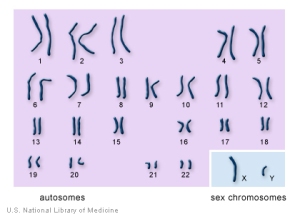 (from http://ghr.nlm.nih.gov/handbook/basics/howmanychromosomes)
(from http://ghr.nlm.nih.gov/handbook/basics/howmanychromosomes)
First of all, there are two ways, in which cells can divide. There is the general cell division that occurs throughout your body all the time, called mitosis. This is where a cell divides into two exact copies of itself. This is not very pertinent to the discussion on evolution, as this is not the type of cell division that leads to the passing on of genetic information to your kids. Fortunately, at that, because otherwise we would double our number of chromosomes for each generation. The other type of cell division is the one that results in our sperm cells or egg cells, of course depending on your favorite color, blue or pink.
You often see chromosomes depicted as small X’s and not as small worms like above. In truth what is depicted above is chromatids and when the DNA is replicated, each chromatid does not just create a separate copy, but in stead ends up as two identical chromatids connected on the middle.
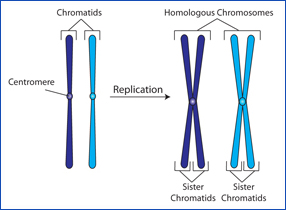 (from http://www.hartnell.edu/tutorials/biology/meiosis.html)
(from http://www.hartnell.edu/tutorials/biology/meiosis.html)
In general, the DNA is not entirely sprawled out, but not all bundled up in the yarn balls we call chromatids or chromosomes. This condensation happens just before the cell division (in mitosis and meiosis alike). So here is where the two types of cell divisions first differ: the newly formed X-shaped chromosomes align in a single file in mitosis, and in pairs in meiosis. In mitosis the two chromatids in each chromosome is pulled apart by threads (kinetochores) that pull the identical chromatids to each side of the cell, before the cell divides into two cells with identical sets of chromatids. In meiosis, the chromosomes line up in pairs, and then something interesting occurs, known as cross-over.
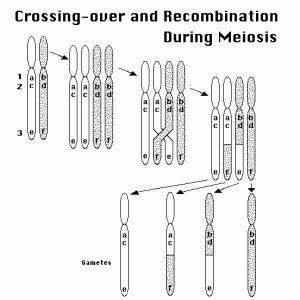 (from http://www.accessexcellence.org/RC/VL/GG/crossing.php)
(from http://www.accessexcellence.org/RC/VL/GG/crossing.php)
Then the chromosomes are pulled apart before a cell division so that each pair is split up between the two cells. Notice the difference here between mitosis and meiosis: in mitosis the “X’s” from above are pulled apart such that each of the two new cells have one chromatid from each chromosome, meaning two chromatids per chromosome pair (all together 46 chromatids from 23 pairs). In meiosis the chromosomes are pulled apart after the cross-over such that each of the two new cells have one still X-shaped chromosome from each pair so that they can no longer be called pairs. After this a second cell division (of each of the two cells) occurs in which the X-formed chromosomes are pulled apart as in mitosis, but as we already split up the pairs, this results in a total of four cells, each with 23 chromatids and no pairs.
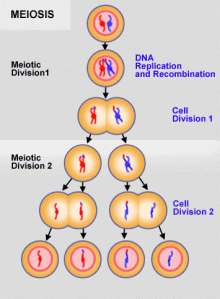 (http://www.tokresource.org/tok_classes/biobiobio/biomenu/meiosis/)
(http://www.tokresource.org/tok_classes/biobiobio/biomenu/meiosis/)
Phew, ok this was a lot, huh? But why the thorough description of how cells divide, before talking about evolution? Well, because there are several points in which the genetic information is changed. I won’t go into much detail on the whole evolution debate, but I will make a few points after this lengthy description of meiosis.First of all, some have said that they concede to what they call micro-evolution, such as can be seen in dogs being bred to change in a certain way. They argue that the cross-over can re-shuffle the genes so that over time you can get all the “good” genes into one individual. The creation of new information, however, is seen as something that can only happen via point mutations resulting from faulty DNA replication when the chromatids are replicated (resulting in the X-shaped chromosomes). In order for natural selection to work, all intermediate forms of a given protein must be functional, which can make great leaps in development quite inprobable, given the rarity of point mutations. But the cross-over is not constrained to the borders between genes, but instead occurs at random locations. Cross-over can recombine the DNA in ways resulting in all new proteins in much greater leaps than point mutations. Areas that might not really code for anything at all can suddenly create a whole new protein. Furthermore, some say that the rarity of mistakes in DNA replication makes evolution way to slow to have made the rich diversity of life on this wonderful planet. But let’s look briefly at how DNA is replicated:
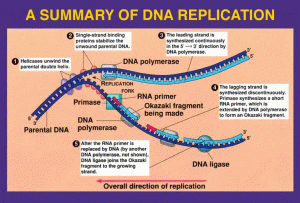 (from http://www.tokresource.org/tok_classes/biobiobio/biomenu/dna_replication/index.htm)
(from http://www.tokresource.org/tok_classes/biobiobio/biomenu/dna_replication/index.htm)
Helicase “unzips” or separates the two strands of the double helix that is DNA. Then DNA-polymerase makes a copy of each of the now removed strands. Very few times does DNA-polymerase make mistakes. But DNA-polymerase is not excluded from the principle of evolution by natural selection. It did not first arise as this near perfect replicating machine. The more precise and dependable the DNA-polymerase became, the better the chance that exactly that version of the DNA-polymerase was passed on as it would have a lower risk of a faulty replication of the gene for the polymerase itself. And we see in nature how DNA-polymerases differ. In polymerase chain reactions (used to make a large number of copies of a piece of DNA) utilizes cycles of heating, that would render the human DNA-polymerase useless. This can only be done by using the DNA-polymerase found in the bacteria Thermus Aquaticus, which is found in hot geysers. To get back to the point I’m trying to make: the DNA-polymerase has not always been as precise as today, and as such the frequency of mutations, and thus the number of new varieties in nature must have been higher in the past.
I apologize if the ending got a little off-topic and messy, but I hope you enjoyed the post anyways, and may have learned something new. I am no expert in this field, and do not work with genetics or cellular biology. I have been working as a TA in cellular biology back in the days and hopefully I have remembered most of it correctly.
As always, please comment – especially if I have made any mistakes.
Suggested reading:
http://www.tokresource.org/tok_classes/biobiobio/biomenu/meiosis/
http://www.cellsalive.com/meiosis.htm
http://www.biology.arizona.edu/cell_bio/tutorials/meiosis/page1.html
http://biology.clc.uc.edu/courses/bio104/meiosis.htm
http://en.wikipedia.org/wiki/Meiosis
Unfortunately I do not remember the names of the books I read in University when I learned about meiosis.